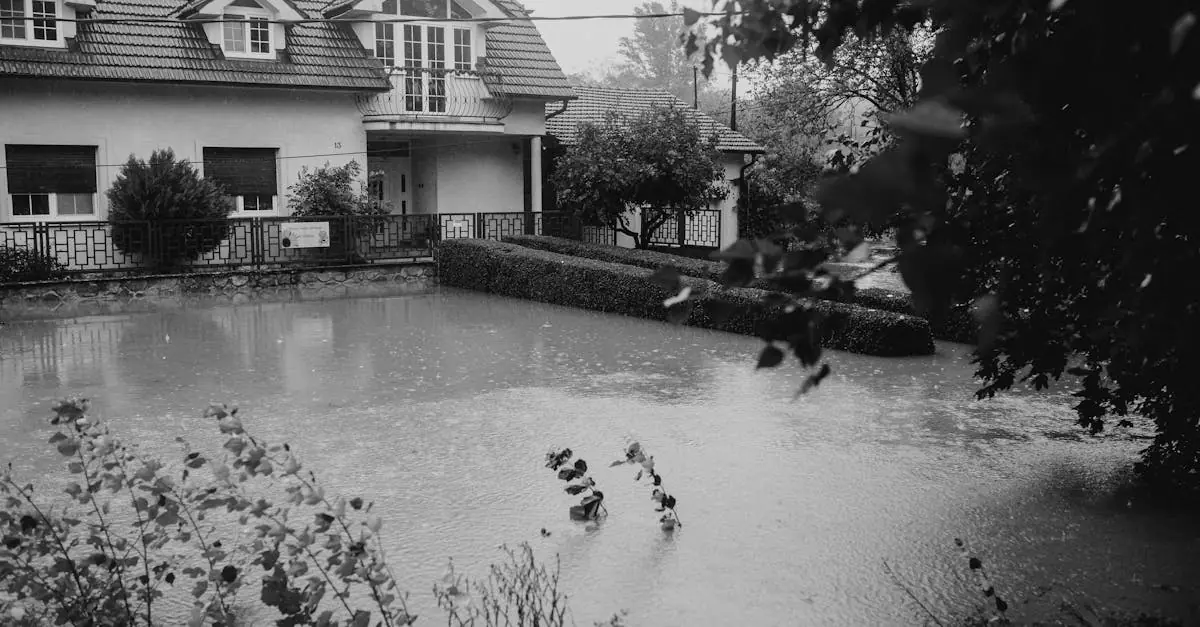Table of Contents
ToggleTornadoes can turn a serene afternoon into a scene straight out of a disaster movie. One minute you’re sipping iced tea on the porch, and the next, you’re dodging flying lawn furniture. Amidst the chaos, homeowners often wonder if their insurance will swoop in like a superhero to save the day. Does homeowners insurance cover tornado damage?
It’s a question that can leave many scratching their heads. While some policies might offer a safety net, others could leave homeowners feeling as lost as a sock in a dryer. Understanding the ins and outs of coverage is crucial for anyone living in tornado-prone areas. So let’s unravel the mystery of homeowners insurance and find out if it has your back when Mother Nature throws a tantrum.
Understanding Homeowners Insurance
Homeowners insurance serves as crucial protection for property owners, especially in tornado-prone regions. Knowing its specifics helps homeowners navigate potential claims.
What Is Homeowners Insurance?
Homeowners insurance is a type of property insurance that covers a private residence. It protects against specific risks, including damage to the home and personal property. Some policies also include liability coverage that protects against injury claims on the property. Understanding policy details is vital, as not all events are covered under standard plans. Homeowners should review their contracts to clarify what their insurance protects.
Key Components of Homeowners Insurance
Several key components define homeowners insurance. Dwelling coverage protects the physical structure of the home against perils such as tornadoes. Personal property coverage insures items inside the home, including furniture and electronics. Additionally, liability protection covers legal costs stemming from injuries on the property. Often, additional living expenses coverage offers financial help when the home is uninhabitable due to damage. A thorough understanding of these components enables homeowners to select the best coverage for their needs.
Tornado Damage Explained
Tornado damage includes various destructive impacts on properties. Homeowners often face significant risks, leading to considerable financial loss.
Types of Tornado Damage
Damage caused by tornadoes can be extensive. Structural damage affects roofs, walls, and foundations. Additionally, debris can puncture windows and doors. Personal belongings inside homes often incur damage or destruction. Property owners may experience landscaping loss, such as uprooted trees and damaged fences. Coverage availability for these different types of damage varies by insurance policy.
Severity of Tornado Damage
Tornado severity ranges from minor effects to catastrophic destruction. F0 to F1 tornadoes cause light to moderate damage, while F2 to F5 tornadoes result in severe destruction. Homes can suffer extensive damage or complete destruction, depending on the tornado’s strength and path. Losses from strong tornadoes often exceed thousands of dollars in repair and replacement costs. Understanding the severity helps homeowners assess their potential risks and insurance needs better.
Does Homeowners Insurance Cover Tornado Damage?
Homeowners insurance typically provides coverage for tornado damage. Coverage depends on the specific policy and its inclusions.
Coverage Details
Standard homeowners insurance policies usually encompass damage caused by tornadoes. Dwelling coverage protects the home’s structure, while personal property coverage safeguards items like furniture and electronics. Liability coverage may address personal injury claims resulting from an incident during a tornado. In cases where a home becomes uninhabitable due to tornado damage, additional living expenses may cover temporary housing costs. Understanding these coverage details proves vital for homeowners in tornado-prone areas.
Exclusions to Be Aware Of
Not all aspects of tornado damage qualify for coverage under homeowners insurance. Exclusions include damage resulting from neglect or lack of maintenance, which can affect claim approvals. Homeowners should also note that certain policies may limit coverage for specific items or types of damage, such as landscaping or detached structures. Flood damage often requires separate flood insurance, as traditional homeowners policies typically exclude such incidents. Awareness of these exclusions helps homeowners make informed decisions regarding their insurance needs.
What to Do If Your Home Is Damaged
Taking swift action after tornado damage is essential. Homeowners should first ensure personal safety by evacuating the property if necessary. Assessing the damage comes next; documenting it with photos helps create a clear record for future claims. Contacting local authorities for emergencies or structural assessments may provide additional safety guidance.
Immediate Steps to Take
First, turn off utilities to prevent hazards such as gas leaks or electrical issues. Next, secure temporary shelter or accommodations if the home becomes uninhabitable. Prioritize contacting neighbors or family for support, especially those with similar experiences, as they may offer valuable advice. Collecting essential documents, including insurance policies, will aid during the claims process. Make a list of damages as well as any belongings affected to provide a detailed account later.
Filing a Claim
Start the claim process by calling the insurance company promptly. Provide them with the necessary documentation, including photographs of damages and a list of affected items. Be ready to discuss any specific coverage details mentioned in the policy for tornado damage. Following up with adjusters can help clarify processes and timeframes. Maintaining records of all communications ensures transparency throughout the claim process. Each step undertaken strengthens the claim and enhances the support received from the insurance provider.
Understanding homeowners insurance coverage for tornado damage is vital for property owners. While most standard policies do provide some level of protection against tornado-related destruction, specifics can vary widely. Homeowners need to carefully review their policies to ensure they have adequate coverage for both structural and personal property damage.
It’s equally important to be aware of exclusions and limitations that could affect claims. By staying informed and prepared, homeowners can navigate the complexities of their insurance and take necessary steps to protect their investments in the face of nature’s unpredictability.





